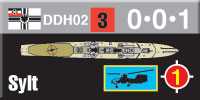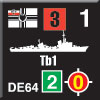The Cruel Sea:
German Escorts, Part Two
by Mike Bennighof, Ph.D.
June 2019
 With the fleet destroyers increasing in size and trending toward specialization in surface combat, the High Seas Fleet had a growing need for ships to serve in the vital escort role. The large number of V170-class destroyers left from the post-war building program could help toward this end, but new modern vessels were also needed. With the fleet destroyers increasing in size and trending toward specialization in surface combat, the High Seas Fleet had a growing need for ships to serve in the vital escort role. The large number of V170-class destroyers left from the post-war building program could help toward this end, but new modern vessels were also needed.
In the Second Great War alternative-history setting, we’re creating not just ships and scenarios in which they can fight, but an entire world in which they exist. That includes both technology, and the power politics of a very different alignment of nations.
In the world of the Second Great War, development of fixed-wing aircraft isn’t as advanced as in our own history, but that of rotary aircraft (helicopters and autogyros) has moved faster. So have submarines, but the helicopter has become a very effective anti-submarine warfare platform. Germany and Imperial Russia have led in helicopter development, though other nations deploy them as well.
 While the High Seas Fleet has built a class of dedicated helicopter carriers, they lack the flexibility demanded in escort work. The Imperial German Island-class destroyer is intended as a specialized escort boat, though one capable of carrying out traditional destroyer missions as well. While the High Seas Fleet has built a class of dedicated helicopter carriers, they lack the flexibility demanded in escort work. The Imperial German Island-class destroyer is intended as a specialized escort boat, though one capable of carrying out traditional destroyer missions as well.
In Second Great War at Sea: The Cruel Sea, the Island class is based on the Nazi German Type 1938B design (which appears in its original form in Plan Z, as the Z64 class). The original design request called for a small, low-cost destroyer suitable for operations in the North and Baltic Seas. In keeping with Nazi gigantism, the architects came back with a 2,000-ton boat powered by complex high-pressure steam boilers good for 50,000 horsepower and 36 knots. She carried four 127mm guns in two twin gunhouses, one forward and one aft, eight torpedo tubes, rails for laying mines and racks for dropping depth charges.
The Island class has a similar hull form, but much smaller (about 1,200 tons) with a conventional steam power plant that should deliver about 32 knots. While the Type 1938B was allegedly intended for coastal operations, the Island class has the range to operate in the Atlantic as a convoy escort, though it will require refueling to keep station.
The class has no torpedo tubes, a huge contrast to German practice whether Imperial, Weimar or Nazi. One twin gunhouse is located forward, and the other amidships. That clears most of the after deck for a helicopter pad and hangar; the aft-most part of the ship (accessible by passageways under the helicopter deck) is given over to her depth-charge racks, with four more depth-charge throwers located amidships on either side of the gunhouse.

An Fl.282 Kolibri helicopter is guided in for a shipboard landing.
The guns are the same 127mm C/41 guns and twin gunhouses carried by the big Storm Bird destroyers (and the Type 1938B; all German 128mm and 127mm guns were actually of the same 128mm bore). They’re low-angle weapons, and like other German destroyers she carries no direction-finder to allow them to be used in the anti-aircraft role. An array of lighter weapons provides all of her anti-aircraft defense: 20mm and 40mm automatic cannons.
All of that’s in keeping with her role to detect and destroy enemy submarines, and in that she is considered a very effective warship. At the outbreak of war none of the boats are complete, with four working up. All are attached to the High Seas Fleet (and thus present in The Cruel Sea); another 16 are under construction with 20 more ordered as part of the War Emergency Program.
 Less useful in the escort role are the Type 1936 torpedo boats, laid down in 1936 and completed in 1937 and 1938. In our own reality, Italy, France and Japan built torpedo boats in some quantity to take advantage of the loophole in naval arms treaties that put no limit on the number of vessels built that displaced 600 tons or less. The result in each case was a class of miniature destroyers (or in the case of Italy, several such classes) that proved greatly disappointing in service. Less useful in the escort role are the Type 1936 torpedo boats, laid down in 1936 and completed in 1937 and 1938. In our own reality, Italy, France and Japan built torpedo boats in some quantity to take advantage of the loophole in naval arms treaties that put no limit on the number of vessels built that displaced 600 tons or less. The result in each case was a class of miniature destroyers (or in the case of Italy, several such classes) that proved greatly disappointing in service.
In the world of the Second Great War, there is no limit on the number of destroyers that can be built by any signatory to the arms control treaties. Only battleships and battle cruisers are limited in number. The only obstacle to launching an unlimited number of destroyers is their cost. Even such a relatively small warship is still expensive to build.
With the wartime V170 and S113 classes aging, Grand Admiral Johannes Hartog sought replacements for them, preferably a large number of boats of the promising new Storm Bird design. The single proposed “fiscal flotilla” – 20 boats – was not enough, he argued, given the approaching threat of war and the looming mass retirement of the older destroyers.
Despite the political power of the “unholy alliance” of the Navy’s political allies and the Socialist-dominated shipyard labor unions, Hartog lost his bid for a second flotilla of big destroyers. Unwilling to cross the unions or be seen as unwilling to defend the Empire, the opposition Catholic Center party offered a compromise: a 20-boat flotilla of so-called “Baltic destroyers,” an 800-ton vessel intended for operations in coastal waters.

A German torpedo boat shows off her aft armament.
The resulting Type 1936 torpedo boat has a nominal displacement of 800 tons, but as built they were closer to 950 tons. Unlike the destroyers of The Cruel Sea, this vessel isn’t really based on a real-world design. The torpedo boats designed or built under the Nazi regime were either terrible fighting ships (like the Type 1935) or not torpedo boats at all but full-sized destroyers (like the Type 1939).
The Imperial Type 1936 torpedo boat has a heavy torpedo armament, with eight tubes, and carries three 105mm guns as her main armament. She has the standard, conventional steam power plant similar to Imperial destroyers, though sized for the smaller boat, and can make about 32 knots.
Despite her small size, she’s been maximized for surface combat, intended to take the place of “real” destroyers in coastal waters. It’s not a very effective compromise, and the Type 1936 torpedo boat is not a very effective fighting ship. After eight of them had been laid down the remaining dozen were cancelled, and replaced by Island-class escort destroyers. The eight torpedo boats appear in The Cruel Sea, but see little action as the High Seas Fleet does its fighting in the Arctic and the North Atlantic.
You can order The Cruel Sea right here, right now.
Sign up for our newsletter right here. Your info will never be sold or transferred; we'll just use it to update you on new games and new offers.
Mike Bennighof is president of Avalanche Press and holds a doctorate in history from Emory University. A Fulbright Scholar and award-winning journalist, he has published over 100 books, games and articles on historical subjects.
He lives in Birmingham, Alabama with his wife, three children and his dog, Leopold. Leopold fears ocean waves.
|
